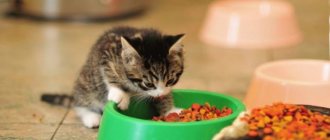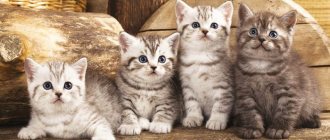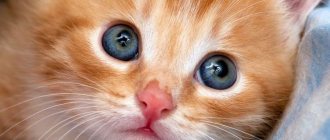A mother cat takes care of her babies independently for the first four to five weeks. Usually at this age the breeder introduces complementary foods, gradually accustoming the babies to adult food. Previously, it was a whole science with counting calories and balancing. But now there is a wide choice of what to feed a 1.5 month old kitten - veterinarians consider all options equally safe. Of course, if you follow the basic dietary requirements.
Milk replacer
Many kittens at one and a half months still eat their mother's milk, but already need additional feeding: a large litter, poor lactation, the cat is exhausted. But not all kids are ready to eat adult food. For example, large Maine Coons, Persians and Britons take longer to develop. Weak, painful offspring are also formed slowly.
A high-quality cat's milk replacer is the best thing you can feed a 1.5-month-old kitten that is developmentally delayed. It will allow you to quickly gain weight and saturate your body with essential nutrients.
Milk substitutes are produced by many well-known brands:
- Cat-Milk (Gimpet);
- Babycat Milk (Royal Canin);
- Kitty-Milk (Beaphar);
- Kittens Powder (Nurturall-C);
- Katzenmilch (Canina).
Professional substitutes contain additives - taurine, vitamins, minerals, vegetable fats. Taking into account the age and condition of the cat, sometimes they even exceed the composition of mother’s milk. Dilute the powder according to the instructions, give according to the scheme in it. To save nerves and time, it is better to purchase a bottle. It costs a penny, eliminates the need to fiddle with a pipette or syringe without a needle, getting everything dirty. It also has convenient divisions to measure out the required amount of mixture.
Features of feeding kittens in the period from 1 to 2 months
One and a half months is a transitional period for a kitten, since at the age of 1 month he is still fully breastfed, and at 2 months he can already eat the same food as an adult cat, only in small quantities and in crushed form. Usually, at one and a half months, the kitten is already accustomed to solid food - cats begin to feed it to them from 3 weeks, so you no longer have to do this. But solid food is not yet pieces of raw meat or fish, but mainly liquid cereals and special milk mixtures with the addition of crushed natural food. If there are no such formulas intended for kittens, you can feed him regular baby formulas with the addition of ground cereals. The temperature of the mixture should be 24-26 degrees. This is the age of intensive growth, when the kitten gains 25 g of weight every day, so take into account its growing needs by adjusting the amount of food. The kitten should be fed 4-5 times a day and be sure to ensure that it always has fresh and clean water in its bowl.
If you feed your kitten with special dry food intended for such babies, do not forget that up to 4-5 months this food must be pre-soaked in water.
Baby food
It happens that it is not possible to buy good food, and there is not enough time or knowledge to create the right menu. If only the incisors have appeared from the teeth, you can feed kittens at 1.5 months with baby food in jars - meat and vegetables. Quick porridges are also suitable, but without fruit additives. It is better to breed them with a cat's milk replacer.
The first is given meat puree. There is no need to try to smear the palate and generally put your fingers in the baby’s mouth, as the “experts” advise. It’s enough to dip your finger and slightly stain your baby’s nose or lips. He will lick his lips, taste the treat and reach for the bowl himself. After two days, if there is no negative reaction, a couple of daily feedings are replaced with a mixed diet: 60% meat puree + 40% vegetable or porridge. If there are problems with the gastrointestinal tract, you can return to supplementary feeding with milk for another week or try changing the brand.
Canned food
It is important to choose premium quality canned food and higher. They are not sold in supermarkets - they offer exclusively toxic garbage with a terrible composition for the price of sawdust. Exception with a very big stretch for the most extreme cases: Gourmet, Sheba, “Our Brand”.
High-quality canned food contains all the beneficial substances a 1.5-month-old kitten needs. And rather than feed your baby haphazardly from the table, it is definitely better to buy a ready-made nutritious lunch. Canned food is given according to the manufacturer's recommendation from 2 months, but fermentation can reduce this age to 6 weeks. Such elements are already semi-digested, they are easier to digest and do not burden the gastrointestinal tract. Of course, we are only talking about good food for the little ones:
- Animonda, Nature's Protection;
- 1st Choice, Brit Care, Almo Nature;
- Hill's, Pro Plan, Royal Canin.
Canned food cannot be combined with natural products; you need to choose one. The final chemical composition of the intestinal flora and gastric juice is still being formed. The ready-made diet contains easily digestible elements to which the baby’s digestion quickly gets used to. Digesting regular food requires different enzymes and more time. Therefore, the combination of canned food and natural food causes stress and disrupts the functioning of the gastrointestinal tract.
Kitten games at 1.5 months
Various cat toys are suitable for games: mice, fly balls. Although so far the best toy for kittens is a rustling candy wrapper tied to a long thread. When playing with the kitten, do not use your hands, do not allow the baby to bite or scratch them. Mother cats bite kittens who are playing too much so that they understand that they are causing pain and stop. Of course, no one is forcing you to bite kittens, but tell the little sharp-toothed one clearly “No” and stop playing for a while.
It is not difficult to accustom a 1.5 month old kitten to a scratching post. Kittens love to climb and climb everywhere. Take your favorite teaser or a string with a candy wrapper and slowly move them around the scratching post; the kitten, hunting for the toy, will involuntarily begin to sharpen its claws.
Perhaps such a small kitten will cause you a lot of trouble, but if you do everything right and are loving and patient, then after a while you will be able to be proud of your affectionate and obedient furball.
Did you like the article and was it useful? Please share with your friends.
Dry food
According to nutritionists, before 3 months. Don't give kittens dry food often. It is offered once or twice a day instead of the usual canned food. The highest demands are placed on this type of feeding. Ideally it should be holistic with around 50% meat content and no grains.
Low quality ingredients, fermented and concentrated - a powerful poison that causes irreparable harm to a growing body in just a few weeks. High-quality dry food, on the contrary, will satisfy all nutritional needs:
- AATU, Applaws, Barking Heads;
- GO and NOW Natural holistic lines;
- Summit holistic, Hill's, Royal Canin.
Hard granules are still difficult to bite through, but whole ones can be choked. First, they are steamed with very warm water, but not boiling water. Pour a little into a bowl and cover with a lid, let stand for 5-7 minutes until the balls are completely swollen. Then check if it is hot, and you can feed the kittens. At 1.5 months, the daily requirement varies greatly among different brands. There are recommendations on the packaging, taking into account age and weight - it is important to follow them.
Natural products
The digestion of cats at the genetic level is very different from the characteristics of the gastrointestinal tract of humans and dogs. Beef is no closer to Murka than ready-made food from a bag. Natural food will include mice, birds, frogs, lizards, beetles and grass as a source of coarse fiber.
The word “natural” itself sounds very attractive, close to nature. It seems that this is the only correct way to feed a small kitten at 1.5 months old - with fresh, real food, and not with something incomprehensible from a jar. And this is wonderful, but it’s quite difficult in terms of selecting an individual menu:
- Medium fat cottage cheese is the first complementary food. You can add a raw yolk to it or crumble a boiled egg. Protein cannot be eaten raw; it binds and removes B vitamins. Sometimes cottage cheese is replaced with non-acidic yogurt, which is better if homemade. Dairy products are given in the morning and every other time at lunch.
- Meat takes up only about half of the diet - beef, rabbit, lamb, chicken, turkey. In nature, a cat eats prey along with bones, intestinal and stomach contents, liver, skin, feathers or fur. Feeding kittens only meat leads to chronic renal failure and toxic liver damage. The piece is frozen for three days and finely chopped. Minced meat does not linger in the gastrointestinal tract, “flying” in vain. Instead of freezing, chopped pieces can be kept in boiling water for 10 minutes.
- Vegetables are added to the meat in a ratio of 40/60 - carrots, zucchini, sweet potatoes, cauliflower, boiled or grated raw. Small kittens at 1.5 months. You should not feed vegetables often; at this age, the emphasis is on a milk-meat diet. Twice a day is enough to meet fiber needs.
- Cereals are digested only fermented, from the intestines and stomach of prey or from industrial feed. Unpolished boiled rice is included in the menu as ballast to prevent protein poisoning. This scourge specifically threatens domestic cats, because they move too little.
- Any offal, but only in boiled form. Chicken hearts and stomachs can be given scalded and finely chopped. Liver is added to meat to diversify food sources. For example, this serving option: turkey 30% + chicken liver 30% + vegetables or grains 40%.
Fish is a very controversial product. It is useful for healthy cats, despite the mountain of myths. In nature, for many cats, this is half the diet.
But feeding small kittens fish is not recommended. If you decide to include it in the menu, it should be sea, white and lean, boiled and thoroughly deboned.
Fiber and vitamins
What to feed a kitten from one month old to older age? Nutrition should be based on vitamins and fiber, since this period is the most productive. That is, if at this age there was a deficiency in any necessary substance, then in the future the cat may often get sick and not gain the required weight and height. Ideal products for replenishing all the necessary substances are cucumbers, all kinds of greens and apples. Only these products cannot be cooked; they should be added raw. To do this, grate them on a fine grater, squeeze out the juice and add it to porridge or pureed soup made from vegetables and meat.
Basically, these are all the necessary products related to the question of what to feed 1.5 month old kittens in the absence of a cat. If you follow all the veterinarian's recommendations (our article is based on this), then your baby will grow into a large, active, healthy cat.
General rules
The suckling babies are fed additionally when they clearly stop eating enough on their own: they squeak, tug at their breasts with force, and do not let the cat go away from them. Or the mother herself leaves due to cessation of lactation, forcing her to leave a half-starved litter. If there is no milk at all, they switch to feeding in small portions every 3-4 hours with a night break of 6-7 hours:
- Leftover food is always removed, since a 1.5 month old kitten can only be fed under supervision. With the introduction of complementary foods, water is placed in wide, shallow and stable bowls. It is changed twice a day.
- Food should be lukewarm or at least room temperature. Cold and hot food causes indigestion. Long-term consequences include inflammation of the small intestine, chronic gastritis, colitis and other joys.
- Digestion is still very vulnerable, and the body is developing at a speed that is crazy by human standards. Therefore, it is important to follow the regime so that the gastrointestinal tract works well. Products are only high quality and fresh.
- To properly feed small kittens at 1.5 months, it is important to introduce only one new product per day. If your baby reacts with diarrhea, vomiting or allergies, you won’t have to guess what exactly caused the reaction.
- The menu is adjusted upon reaching 4 months. Increase the portion and reduce the number of meals to three times a day. Grown-up kittens eat almost like adults - in larger pieces, learning to tear apart the “prey”. This is good for the gums and prevents tartar deposits.
When feeding dried or canned food, it is important to monitor the condition of the dental system. Inflamed gums, plaque or an unpleasant odor indicate the need to change the brand. If the choice fell on natural food, it is better to create a menu together with a competent veterinarian.
Feeding kittens from 1 to 3 months
The birth of kittens is always a long-awaited and exciting event for owners. Watching squeaking fluffy balls sucking their mother's milk causes tenderness and joy. Kittens suckle only 3-4 hours a day, and devote the rest of the time to sleeping and playing. However, we should not forget that soon the burden of responsibility for feeding the babies will fall on the owners, because without harm to their own health, the cat feeds the kittens for only 1.5-2 months.
photo: A cat can feed kittens for up to 2 months
Properly selected and well-balanced nutrition early in a kitten’s life lays the foundation for its future health. Depending on the age of the baby, he needs different nutrition, which, in any case, should include only high-quality products. When the kitten is 3-4 weeks old, you can start feeding the baby with other foods. During this period, kittens gradually wean from their mother and are ready to try something other than mother's milk.
photo: Milk is the basis for the transition to normal feeding of a kitten at 1 - 3 months
To ensure that the transition to adult food does not affect the pet’s health and does not lead to unnecessary stress, complementary feeding begins with soft or liquid food rich in protein and vitamins. Children's meat and semi-meat purees are ideal for this. From 1.5 months, it is already possible to introduce more solid foods into the diet, for example, minced raw lean meat with vegetables. From 2 months, the kitten can be given meat cut into small pieces. At the initial stage, milk, cottage cheese, sour cream or kefir are added to almost all food, since it is easiest for kittens to switch from mother’s milk to fermented milk products. Dairy products, which are so necessary for babies to fully develop, continue to be given until the kitten reaches 4 months of age.
photo: New foods should be introduced gradually into the diet of a 2-3 month old kitten
With natural feeding, in addition to dairy products, chopped meat, fish, vegetables and cereals are added to the kitten’s diet. All new foods should be introduced gradually and given separately from other foods.
It is customary to feed a kitten from 1 to 3 months 5-6 times a day in small portions. Food should not be cold or hot. The diet of any kitten from 1 to 3 months should include the following products:
- Meat. Lean meat (beef, poultry, rabbit) makes up 60-80% of a kitten's daily diet. It is given raw, boiled or scalded with boiling water. Before consumption, raw meat must be frozen in the freezer for 4-5 days to protect the pet from possible parasites.
- Liver. Chicken and beef liver once every 1-2 weeks.
- Porridge. Buckwheat, millet or rice porridge with the addition of minced meat, meat, fish or vegetables is the most nutritious food for babies.
- Vegetables. Vegetables are very healthy and simply necessary for a growing body. They are given fresh or boiled, after being grated.
- Eggs. Raw egg yolk is given no more than once a week. A mixture of milk and egg yolk is very healthy and nutritious.
- Dairy products.
The most harmful foods for kittens are pork, fats, fresh meat, sugar, salt and smoked meats. Giving such products to children is strictly not recommended.
photo: A carefully selected diet is the basis of your cat’s health!
If further feeding is planned with ready-made industrial food, complementary feeding also begins at one month of age with the addition of several dry food granules soaked in milk or specialized canned food for kittens from 1 to 3 months. The composition of ready-made food includes almost the same ingredients as in natural feeding. The proportion of a particular product in the feed depends on the class of the finished feed. The daily dose of feeding a kitten in accordance with its age and weight is indicated on the package. When feeding dry food, the kitten should always have unlimited access to fresh water.
By 2.5-3 months, the kitten has already completely switched to adult food. The only difference is in the frequency of feedings and portion size.
photo: The kitten’s transition to adult food should be completed by the 3rd month of life
A balanced diet for a kitten in the first months of life is a fundamental factor in its harmonious development and good health. By following the tips described above, you can provide the right diet for your little pet.











